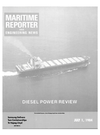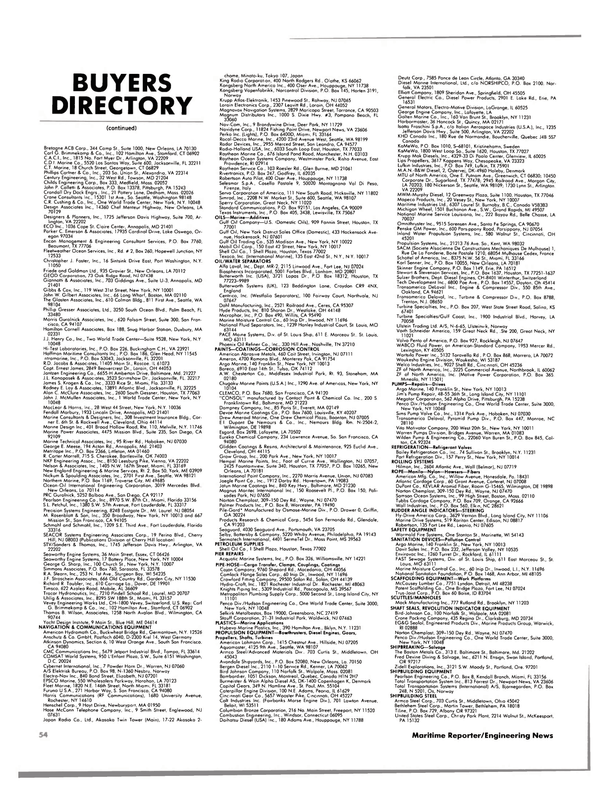
Fast Navy Supply Ship Capella Dedicated At Pennsylvania Shipbuilding
The first of the U.S. Navy's new class of fast supply ships, the USNS Capella, was dedicated recently at the Pennsylvania Shipbuilding Company's yard in Chester, Pa.
U.S. Senator Arlen Specter (RPA), was the keynote speaker; his wife, Philadelphia Councilwoman Joan Specter, dedicated the ship.
Rear Adm. Warren C. Hamm, USN, Deputy Commander, Military Sealift Command, also spoke at the ceremony.
The dedication ceremony began with an invocation and concluded with the traditional breaking of a bottle of champagne on the ship's bow. Shipyard employees and their families attended, as did many local residents and invited guests.
The Capella is one of the Navy's largest and fastest auxiliary ships.
With an overall length of 946 feet, beam of 105 feet 6 inches, depth of 66 feet IV-i inches, and draft of 36 feet 8 inches, the 24,000-dwt vessel is powered by a General Electric/ Foster Wheeler steam turbine plant of 120,000 shp that gives her a service speed in excess of 33 knots. She carries tanks, armored personnel carriers, helicopters, and other wheeled equipment for an armored division of the U.S. Army.
In one typical arrangement, she will carry 122 M-l tanks, 183 helicopters of various sizes, and other assorted wheeled equipment.
Helicopters can land on and take off from two landing pads on the topmost deck, and can be stored in the space below it. Tanks and wheeled vehicles are loaded through a special door on each side of the ship. Each door is fitted with a 73- by 20-foot folding ramp that has a design capacity of 65 tons. These doors give access to 185,000 square feet of stowage area distributed over four decks that are connected by internal ramps.
The heavy duty, 35-ton cranes are fitted amidships to handle loads over the side of the ship, and two more, each of 50 tons capacity, are fitted aft for the same purpose and to serve four cargo holds that are arranged to carry both standard 20-foot and 35-foot containers and up to eight Sea Sheds—open-frame cargo-carrying devices, 35 by 25 by 8 feet—that fit into the same space as three standard containers and are designed to carry outside and extra-heavy (up to 70 tons) loads. Each pair of cranes can also be worked in tandem to provide 70-ton lifts.
The Capella and her sister ships will be independent of port facilities, and can load and unload directly from or to floating causeways, barges, or other ships—a flexibility that can be extremely valuable in an emergency.
The Capella was built by Rotterdam Dockyard in the Netherlands in 1972 as the Sea-Land McLean.
She was the first of a revolutionary new class of eight large containerships, known as SL-7s, built in Europe for Sea-Land Service, Inc. for operation in the U.S. foreign trade. At the time, these ships were the largest pure containerships ever built, with a capacity of 1,096 thirty-five foot boxes. What made them unique, however, was their speed. At 33 knots, they could cross the Atlantic in four days and operate a twoweek sailing schedule comfortably.
They are still the fastest commercial cargo ships of any size or type ever built.
The Capella and three sister ships—Algol, Antares, and Bellatrix— will be operated for the Military Sealift Command by Sea-Land Service under a three-year $19.7- million contract just awarded by the Navy. Under the contract, Sea-Land will man, operate, and maintain the ships in a reduced operating status with a minimum crew aboard. Two of the vessels will be based at Jacksonville, Fla.; the other two will be berthed in Violet, La. They will be placed in full operating status for 30 days a year for training and exercises purposes.
Sea-Land sold the eight SL-7s to the Navy in 1982 for a total of $271 million. The other four are currently being converted into fast supply ships, and are scheduled to be redelivered to the Navy between October 1985 and March 1986.
Read Fast Navy Supply Ship Capella Dedicated At Pennsylvania Shipbuilding in Pdf, Flash or Html5 edition of July 1984 Maritime Reporter
Other stories from July 1984 issue
Content
- Tacoma Boat Awarded $110-Million Contract To Build Passenger Liner page: 4
- Williams Announces Lubricating Innovation For Steel Cables page: 5
- Hitachi Zosen Delivers Bulk Carrier To Greek Owner page: 5
- Cummins Engine Announces New Engine Model Codes For Marine Product Line page: 5
- Desco Marine Adds Three New Fiberglass Hulls To Line of Fishing Boats page: 6
- Two Appointments Announced By Marathon Marine page: 6
- Engineering Partnership Formed By Kongsberg And McDermott International page: 6
- Deutsch Metal Offers Free Pyplok Catalog page: 6
- Unique Mini-Liner Nearing Completion At Bender Shipbuilding Yard In Mobile page: 7
- Bender Delivers 98-Foot New Bedford Scalloper page: 7
- Daewoo To Build Offshore Gas/Oil Production Plant page: 8
- Joseph Cangelosi Forms New Consulting Firm page: 8
- Dockside Signs Contract With M.A.N./B&W Service — Rennie Joins Staff page: 8
- Philadelphia Gear Supplies New Propulsion Drives For San Francisco Ferry Boats page: 8
- Gennaro Oliva Joins Atlantic Coast Enterprises page: 8
- Marathon LeTourneau Offshore Announces Major Reorganization page: 9
- Bob Daniels Named New Marland President & CEO page: 9
- NABRICO Names Gower VP-Engineering page: 9
- American-Standard Offers Free Bulletin On FanEX® Air/Oil Heat Exchangers page: 9
- CDI Marine Appoints Smith And Dodson page: 10
- Sonat Subsea Services Appoints Senior VP page: 10
- New Raytheon SSB Is Microprocessor Controlled —Literature Available page: 10
- Comsat TeleSystems Introduces The MCS-9100 Ship Earth Station page: 12
- Socal Announces Executive Changes page: 12
- NOR-FISHING '84 page: 12
- Rockwell International Announces Key Top Management Promotions page: 13
- New Remote Control Subsea Gyrocompass Introduced By Robertson page: 13
- MarAd Acquires RO/RO Vessel Atlantic Bear With Bid Of $17.5 Million page: 14
- NASSCO Holds Naming Ceremonies For Two Ship Conversions page: 14
- Perolin Offers Handbook On Fuel Oil Treatment page: 14
- Two Samsung-built Hapag-Lloyd Ships Feature Unique Asymmetric Stern page: 16
- OFFSHORE NORTHERN SEAS page: 16
- DIESEL POWER REVIEW page: 18
- SCANDINAVIAN SHIPBUILDING page: 23
- Magnavox MX 1100 Series Navigators GPS Upgradable —Literature Available page: 34
- Ingram Materials Expands Bulk Marine Terminal page: 35
- Emerson Shank Joins Desco Marine As VP Sales And Marketing page: 35
- Navy Adding 19 Ships To Ready Reserve Force page: 36
- AMR™ Is New Name For Transamerica Delaval Line Of Three-Screw Pumps page: 37
- Caterpillar Offers Remanufactured Fuel Nozzles And Tune-Up Kits page: 37
- SNAME Issues Call For Papers For 1985 OTC page: 38
- Comsat Dedicates Roaring Creek Earth Station page: 38
- Norcontrol Renews Long-Term Agreement With B&W Diesel page: 41
- Integrated Marine Electronic Systems Nav-Com Inc., Seminar—Washington, D.C. page: 42
- Oceaneering International Dual Hydra Rov Systems At 100 Percent Utilization page: 49
- Fast Navy Supply Ship Capella Dedicated At Pennsylvania Shipbuilding page: 50


